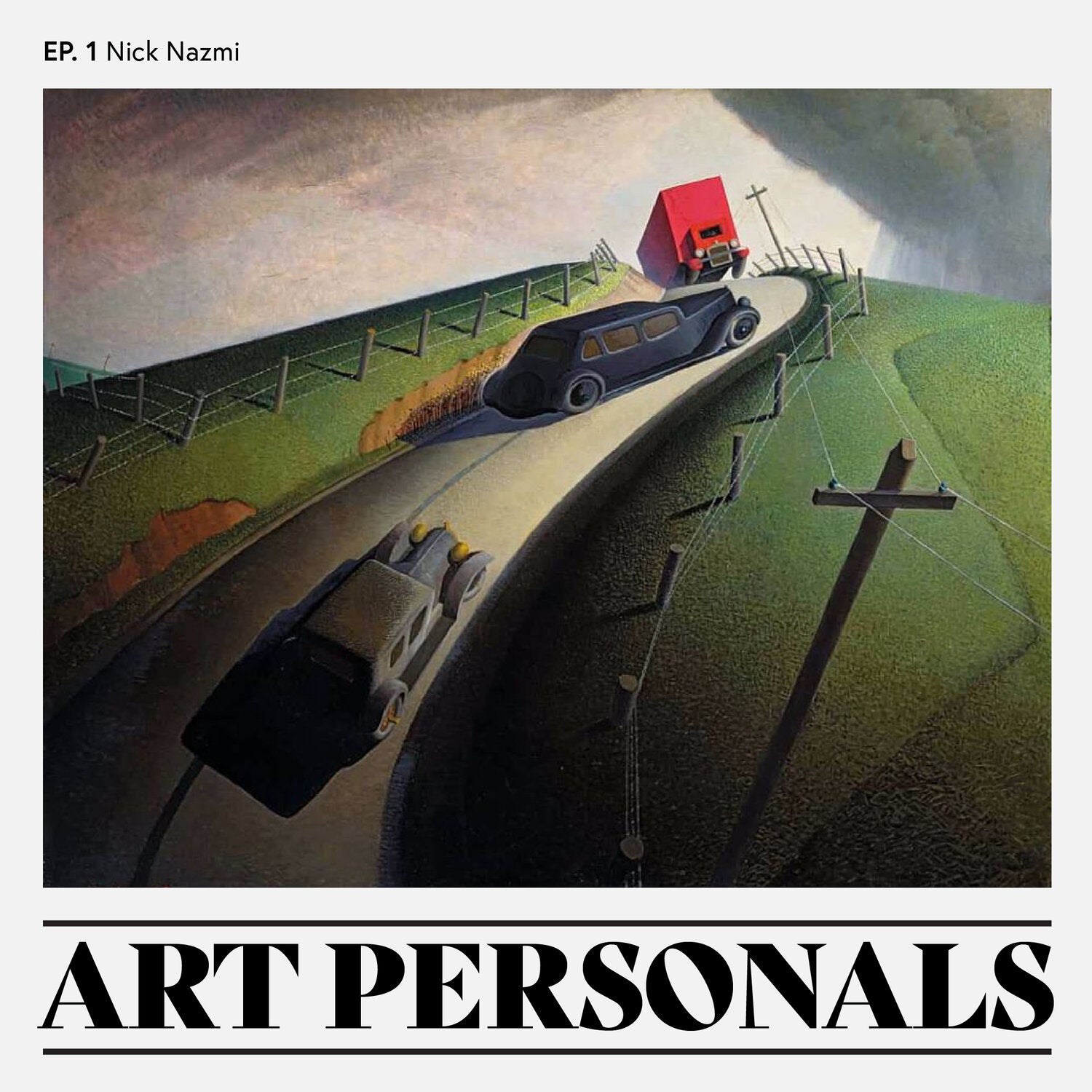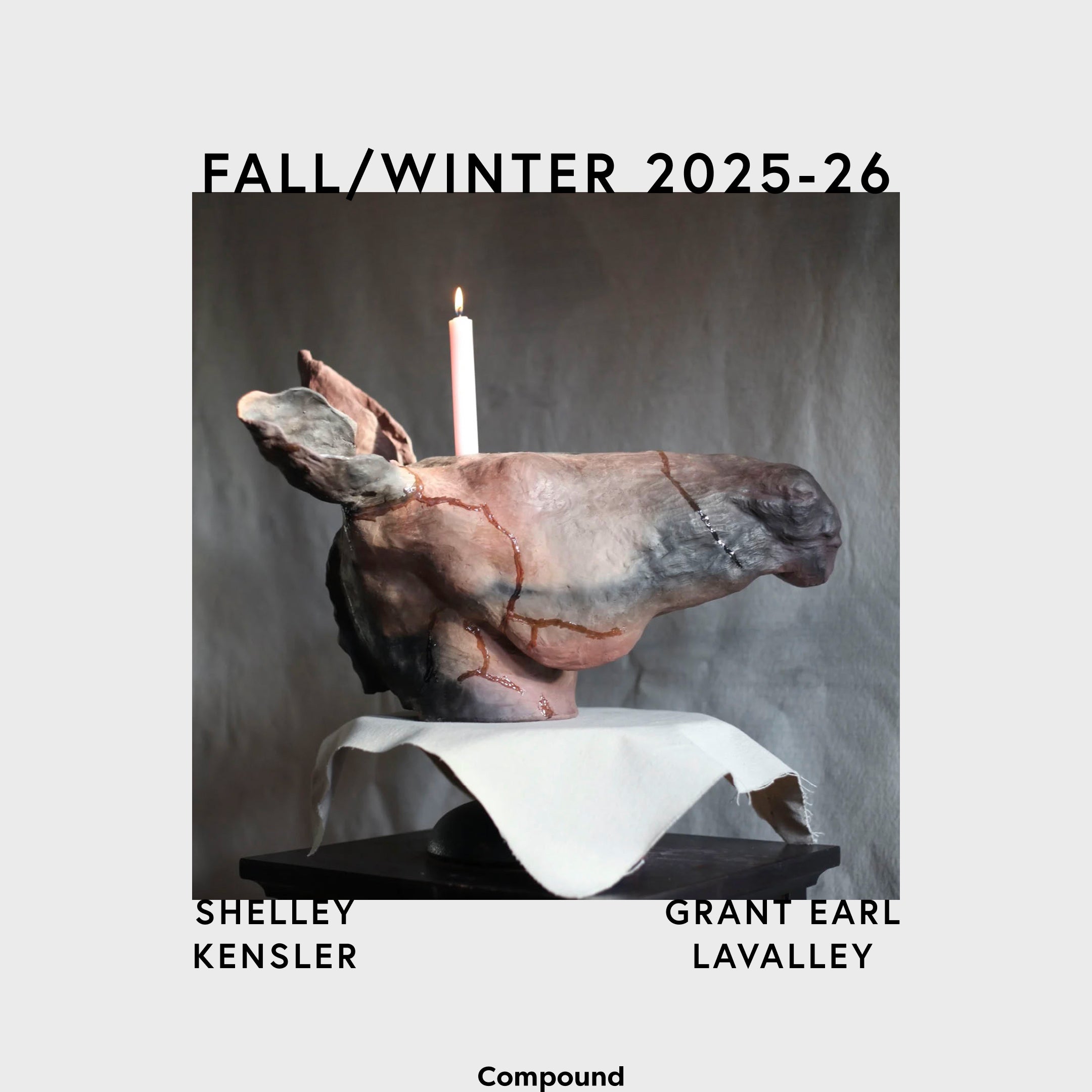Article: Nick Nazmi Describes Grant Wood

Nick Nazmi Describes Grant Wood
Nick Nazmi (b. Chicago, 1991) creates an array of paintings and drawings in which apparitions, lost souls, and characters in a book are stuck in their nostalgia for a time and place that is no longer accessible. His work is influenced heavily by Persian folklore and the poetry of his father and grandfather from Iran. Nazmi lives in Brooklyn, New York.
The paintings he describes in this episode are:

Grant Wood (American, 1891–1942)
Death on Ridge Road
1935
Oil on masonite
32 ⅛” × 39 1/16” × 1 5/16”
Williams College Museum of Art
Gift of Cole Porter

Stone City, Iowa
oil on wood panel
30¼ x 40”
Joslyn Art Museum
Gift of the Art Institute of Omaha, 1930.35; Art © Estate of Grant Wood/Licensed by VAGA, New York, NY
Episode Transcript
Welcome to Art Personals, a podcast made by Compound Yucca Valley, an art and event space in California’s high desert. Here, we ask some of our favorite artists to describe another artist’s work as best they can, with only their words and sounds. The one parameter is that the object they choose must be one they have seen in person at some point in their lives (whether that's an ancient artwork in the Metropolitan Museum of Art or a friend's painting in a garage).
Today, for our first episode, we’ve invited Nick Nazmi, who has chosen to share his experience with two of Grant Wood’s paintings: Death on Ridge Road and Stone City, Iowa. Nick Nazmi is a painter, animator, and filmmaker who currently lives near a haunted graveyard in Brooklyn. He had a solo exhibition at Compound last year called Matters of Suspension.
***
I never really cared that much about that painting. It always felt kind of like Norman Rockwell-esque or, kind of kitschy maybe. And so I never really looked into Grant Wood that much as an artist. Um, but that all changed when I decided to take a sick day off work, not really a sick day, but playing hooky. I headed over to the Whitney Museum in New York, and I was completely blown away by Death on Ridge Road from 1935.
When I first looked at Death on Ridge Road and saw that it was Grant Wood as the artist on the label on the side, I was shocked. I was like, how is this the same artist? American Gothic always felt so simple and straightforward. And, you know, I definitely overlooked it. Death on Ridge Road is this surreal, incredibly dark painting that has so much movement and energy and heavy subject matter in it. You look at it and you just see this scene of death about to unfold.
You got this truck that's on the horizon on this hill on the road. And, these two, it could either be a hearse or maybe a mob type car. I think maybe it's more of a mob type car. It's an old, 1930s car and an accident is just about to unfold. And of course, if you look at the imagery and you can see the symbolism of the power line poles across and you see like the heavens unfolding in the backdrop from this thunderous sky. And I mean, that's all there, but just on surface level, the scene is just so hypnotizing. I mean, I looked at this painting probably for like 15 to 20 minutes, and then I went around and looked at the other paintings of the retrospective and then came back to this one.
And I mean, it's not a big painting. It's like, I'm gonna mess this up right now. I should probably look this up anyway. It's like a medium sized painting. Uh, it's an oil painting and the level of detail and these crosshairs that he does, or just like a technique that's used a lot of the time for creating shading ink and pencil drawing. You can really see it on the surface of almost every single object in the painting, like the surface of the car roof on the bottom and in the grass and the details in the sky. And it's kind of a funny painting in a way, because the proportions and the perspective and the colors and the shapes, it kind of feels like a still from a 90s Nickelodeon cartoon, like Rocko's Modern Life or Hey Arnold or something.
And the wheels on the truck on the horizon are sort of diagonal in a very animated way. And it's really dark. Like these vehicles are about to crash and cause imminent death. But even though that's happening, you're still not quite terrified of the painting. It's sort of addressing this inevitability of death in a way that makes you almost not take it so seriously.
And I think that's because of the way he's had fun with it. And you could tell he had fun making this painting because he could have gone for more realistic depictions of what a truck's wheel might look like or the shapes of the cars, bodies themselves. And I don't know, I just got kind of lost in it.
And as I walked around the gallery, I came across some of his other landscape work, which brings me to, um, his other painting Stone City. Stone City was the first landscape painting that Grant Wood did in what they call a hard edge style, where every edge of the painting is very cleanly, separated from its surroundings, very geometric, very, intent with every single choice he makes. There's no impressionistic quality. There's no blending in between. The shapes of trees and to each other, the way we see it in other impressionistic paintings or even realistic landscape paintings, because in real life, you know, the leaves of trees do mesh into each other in a natural way. But Grant Wood takes those elements and really makes a very dreamy surreal depiction of what I feel like I at least or a lot of people in America kind of see us sort of boring, rural landscapes and people talk about driving through the Midwest through Iowa and it's, it's flat. It's boring. It's the same thing for miles and miles. But Grant Wood depicts this area outside of Cedar Rapids in this incredibly magical way.
I went to college outside of Columbus, Ohio and rural Ohio. And the landscapes are so beautiful there. I think he captures the magic that is overseen in these paintings. And he was heavily criticized for this kind of work. People did not like it. They thought it was too fantastical.
The trees are very bulbous. The shading is really cool, but I think that if you look at some paintings by Hieronymus Bosch, all that's missing from this painting is just scary demons and torture devices and horrifying animals. And you have a Bosch painting here. I mean, it's cool to see a rural American landscape done in this way, because it feels like something you would see out of like a medieval triptych and not an American art piece about an American landscape in the Midwest.
I mean, who cares if the trees don't look real, they're gorgeous. This one tree to the left, it's just got this like triangular pattern within, and it was just draping down and creating this shade and, Grant Wood did paintings that depicted, um, certain fables from American history, like the story of George Washington and the tree getting chopped down and Paul Revere.
I think at an early age, It feels like he got kind of caught up in, um, myth and the American myths that exist. And then that slowly translated to him kind of creating his own mythological interpretations of the surrounding areas, where he grew up and lived and it translates really well. And his landscapes, it just does feel like he's proving the mythological and magical power of the American Midwestern landscape.
It's funny. I read this recently, but the Iowan Republican party had commissioned a painting by Grant Wood of Herbert Hoover's birthplace. And if you look it up, it is a very similar, like, kind of.magical style to this landscape. And when the Iowan Republican party received the painting, they returned it immediately and paid him $0 for it. And that was in the show as well. But man, they were offended by the style, which kind of gives it more value in my opinion.
Yeah. I was really drawn to Stone City more than just because it was a beautiful painting to look at, but that area in the middle, if you're looking at this piece of me right now, it takes place in a limestone quarry. That's what that kind of like edge in the middle of the hill. That's where it starts. It's where the limestone is. It just brought me back to my first painting class, when I was at Kenyon College. Our professor took us out to a limestone quarry for our first, uh, en plein air painting class where we got to bring our canvas and our paints. And we all kind of gathered around this limestone quarry. And she just said to pick an area that spoke to you and the only rules were that you weren't allowed to use matching colors to what you were seeing. So I painted the water purple. I painted the grass blue and the sky green. It was a really cool exercise. It made me really appreciate, not just painting outside, but also gave me an appreciation to the beauty of limestone quarries.
Yeah, I just love Grant Wood's style. It gave me a new appreciation for American painting and realizing that there's a lot of magic that exists in America's natural landscapes and the paintings of America do exist out there. And they're really cool. They're really, really cool.
***
Thanks for listening to Art Personals, a podcast produced by Compound Yucca Valley. You have been listening to Nick Nazmi discuss their encounter with Grant Wood’s Death on Ridge Road and Stone City, Iowa. If you enjoyed today’s episode, please consider supporting this artist whose prints you can now find over on our website at compoundyv.com.
You can learn more about Compound YV and stay tuned for future episodes over at our website and our instagram @compoundyv.
Art Personals is produced by Caroline Partamian, Lara Wilson, and Michael Townsend in collaboration with our artists.
Our interns are me, Emiliano Vazquez and Lilly Villagrana from DATA.
Original music by Ethan Primason.
We curate shows for our virtual and physical spaces. If you are an artist interested in working with us, please send an email to hello@compoundyv.com.



